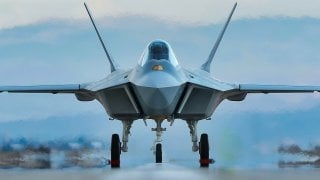TAI TF Kaan: Turkey's New Stealth Fighter Might End Up Being a Dud
Turkey's ambitious project to develop a homegrown stealth fighter, the TAI TF Kaan, recently achieved a significant milestone with its maiden flight at Akinci air base, reaching a speed of 230 knots. But that is just the start of a long development process.
Summary: Turkey's ambitious project to develop a homegrown stealth fighter, the TAI TF Kaan, recently achieved a significant milestone with its maiden flight at Akinci air base, reaching a speed of 230 knots. This fifth-generation airframe aims to replace the aging F-16 Fighting Falcons and serve as an exportable fighter jet. Despite its domestic branding, the TF Kaan relies on international collaboration, notably with BAE Systems from the UK and proposals for joint production of engines with the United States. Featuring advanced capabilities like internal weapons, drone control, and ground attack functions, the TF Kaan still faces hurdles, including budgetary constraints exacerbated by Turkey's economic challenges. The cost per unit has surged beyond the initial $100 million estimate, putting the plan to procure 300 airframes by the end of the decade in jeopardy.
Behind the Wings of TAI TF Kaan: Turkey's Ambitious Stealth Fighter Project
Turkey’s homegrown stealth fighter project reached an important milestone in February. The TAI TF Kaan completed its maiden flight at the Akinci air base near Ankara, registering a speed of 230 knots.
Turkey’s quest to bring its own fifth-generation airframe into service has faced numerous challenges over the years. While its maiden flight is a noteworthy achievement, the TAI TF Kaan will likely not be ready for full-time flight anytime soon.
Overview of Turkey’s Fifth-Gen Fighter Program
More than a decade ago, Turkey’s Defense Industry Executive Committee announced its plans to develop a new fighter platform that could match the capabilities of its near-peers. Around this time, Turkish Aerospace Industries (TAI) penned an agreement with the Turkish Armed Forces to create a conceptual design for the project.
The new jet is meant to replace Ankara’s aging fleet of F-16 Fighting Falcons and eventually to be sold for export. In 2010, Turkey was still in the running to receive the American-made F-35 Joint Strike Fighter, and the homegrown TF Kaan was meant to be an air superiority-oriented partner to that jet. However, Ankara was kicked out of the F-35 program after Turkey procured Russia’s S-400 air defense systems against U.S. and NATO wishes.
Is the TF Kaan Really “Homegrown?”
Although Turkish officials have advertised the upcoming fifth-generation fighter as a product of domestic industry and manufacturing, TAI has already outsourced several components and technologies to foreign entities.
In fact, the Turkish military is collaborating with the United Kingdom-based BAE Systems in the development of the TF Kaan. Previously, Ankara submitted a request to the Pentagon for joint production of the General Electric F110 engine, which also powers the Fighting Falcon. Turkish officials have suggested that the long-term plan is to replace these engines with domestically produced alternatives.
Purported Specs and Capabilities
Turkish state-run media outlets have reported that the TF-X will feature a range of future-facing capabilities, including advanced internal weapons, networked drone control, and ground attack functions. It has also been reported that the TF-X will be built for air-to-air mission sets, like the F-35.
When to Expect the Kaan in Service
Budgetary constraints might be the greatest obstacle preventing the Kaan from entering service with Turkish forces in the imminent future. Last year, TAI CEO Temel Kotil revealed that the price tag associated with the fifth-generation fighter would surpass initial estimates.
TAI had asserted just two years prior that the cost per airframe would remain $100 million per unit. However, Turkey’s economy has suffered greatly over the past few years, significantly impacting the value of the Turkish lira. Without the needed funds in place to secure adequate components for the program, Ankara is unlikely to procure 300 of these airframes by the end of the decade like it originally planned.
About the Author: Maya Carlin
Maya Carlin, National Security Writer with The National Interest, is an analyst with the Center for Security Policy and a former Anna Sobol Levy Fellow at IDC Herzliya in Israel. She has by-lines in many publications, including The National Interest, Jerusalem Post, and Times of Israel. You can follow her on Twitter: @MayaCarlin.


